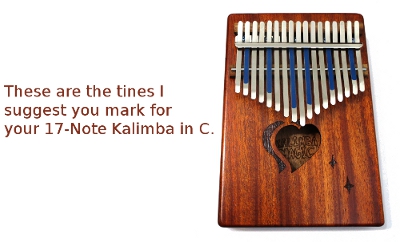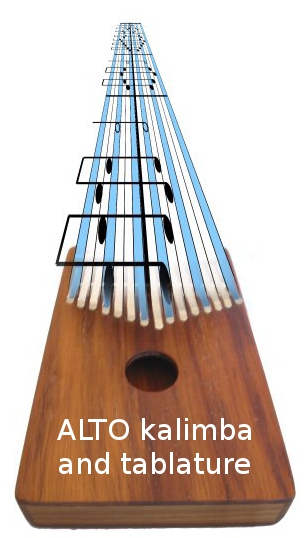When Hugh Tracey started making his 17-Note Treble kalimbas in South Africa in 1954, the instruments had one out of every three tines painted, on each side of the kalimba. These Treble kalimbas ended up with five painted tines, in the key of G, with the low note being B.
Now, a new crop of 17-note kalimbas from China has surfaced under names such as Gecko, Donner, and Walter kalimbas. They are all in the key of C. So while looking exactly like the Treble Hugh Tracey kalimba, they are in a different key, which changes everything. These kalimbas come unpainted with decals for marking the tines, and the manufacturers recommend marking five tines – which is the exact Treble painting scheme. But this can be a problem and here is why:
Tine painting defines how a person learns to play a kalimba and tremendously eases the process of learning songs from kalimba tablature. Hugh Tracey’s Treble kalimba is in the key of G and has its own unique tine-painting layout. But you cannot use Treble instructional materials with your 17-note in C. In order for you to take advantage of the vast offering of Kalimba Magic books, instructional downloads and hundreds of songs that are applicable to the 17-note in C (including all downloads for the 10-note kalimba, 66 Songs for the 17-Note, plus the entire body of Alto kalimba literature) – the Treble’s five-tine painting scheme will simply not work.
By using the six-tine painting scheme outlined in this post, your 17-note becomes part of a world of song instruction, help, and community at your fingertips.
What follows is a more detailed discussion of two kalimbas that look the same but are very different.
Let me start by taking my hat off to the Chinese companies that are making these various kalimba brands. They are fairly good kalimbas for a very reasonable cost – a good value as they say. And the C major tuning the Chinese kalimbas come in is an excellent choice. While the Hugh Tracey kalimbas in G have been great for a variety of reasons, most people find the tuning of the Hugh Tracey Treble to be a bit odd. Putting the 3rd of the scale, B, as the low note of the kalimba makes the kalimba a bit awkward to play. Alternatively, if the root note (or the “1”) of the scale, is the lowest note in the center of your kalimba, it really grounds your playing.
For many years now, I have been offering a modified Treble kalimba with the root note on the low tine. I call it the Bb Treble (pronounced “B flat treble”), and it has six tines painted. The “Bb Treble” can be tuned to A, Bb, B, or C. In other words the Chinese 17-Note kalimba in C is tuned exactly like my “Bb Treble kalimba tuned up to C,” which I have been selling and playing since 2007.
When I started making those 17 Note kalimbas with the root note, or “1” note, on the longest tine, I painted them just like the Alto kalimba, which also has the root note in the longest tine (although they are in different keys). This means that all the songs that I could play on my Alto kalimba (which I had been playing for 20 years at that time) also worked on this new tuning for the 17-Note kalimba. I am still working within the system of “tine-painting logic” that Hugh Tracey started in 1954, and I am extending that logical system to new kalimba tunings. (See the video below for very clear illustration and explanation of various tunings and tine painting.)

A major benefit to you for working within Hugh Tracey’s tine painting system is that it gives you access to my kalimba books and downloads, including materials explicitly for the 17-Note kalimba in C, but also books and downloads I wrote for the 15-note Alto Kalimba (which will instruct you on the inner 15 or your 17 tines).
The kalimba tablature I invented in late 2004 is a map of the kalimba, and represents the painted tines as shaded columns. If your kalimba is painted in a way that is not consistent with my tablature, it will be a real hassle trying to read it.
However, there is a situation now where the best selling kalimbas in the world come with a tine-painting suggestion that would result in preventing those kalimbas from being used with the entire library of Kalimba Magic instructional resources.
This is how it came to pass. For decades, people have been making knockoffs of the 17-Note Hugh Tracey Treble kalimbas. The new brands of Chinese kalimbas starting in 2017 are the latest of those copies. They copied the way the Hugh Tracey Treble kalimba is painted, but not the way it is tuned. Had they asked me, I would have told them to paint six tines, but instead they painted five. You can see kalimbas with this tuning and painting scheme in April Yang’s kalimba videos.
I am firmly planted in the Hugh Tracey tine-painting system.
I won’t make two different books with the exact same painting scheme (ie, apparently identical tablature) but different tunings. How cruel and confusing that would be. You see, I have already written four books and two instructional downloads for the Treble kalimba in G, and those books have tablature with the 5 painted tines.
My new materials for the 17-Note in C, with six painted tines, will never be confused with the G Treble materials.
(OK: I will, upon request, paint any 17-Note kalimba in C with five painted tines instead of my usual six. Why would you want to do this? Because, while it cuts you off from the Kalimba Magic library, it opens you up to the growing number of resources for the 5-painted-tine system.)
Now, here is the silver lining in this big mess: NONE of the new brands of Chinese kalimbas actually come with painted tines!
Rather, they come with six decals that you can stick on your kalimba’s tines. They recommend that you put five on. Kalimba Magic recommends that you put six on, in my scheme. ESPECIALLY if you download any of my instructional materials or buy any of my books. If you already stuck five decals on, I further recommend that you take them off.
And remember – if you own a 17-Note kalimba in C, DON’T get the Treble books or downloads, as the Treble’s tuning is incompatible with your kalimba. It will not work, unless you retune your kalimba to G. Huh!? That got your attention!
I hope this explains both the confusing situation with the 17-Note kalimbas and what you can do about it. It seems to me you have several choices:
The links below in “Related Articles” indicate all the currently available resources that will work for your 17-Note kalimba in C. The first two have recordings in C, and the rest list their various caveats.
The video below illustrates the relationship among kalimbas painted in this scheme.


Sign up for our newsletter and free resources with your email address:
We pinky promise not to spam you and to only send good stuff.
 Christmas in July 2025
Christmas in July 2025 Patriotic and American Music for Kalimba
Patriotic and American Music for Kalimba